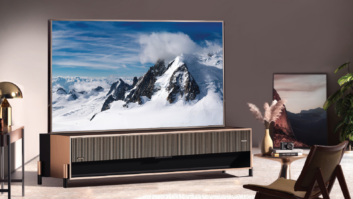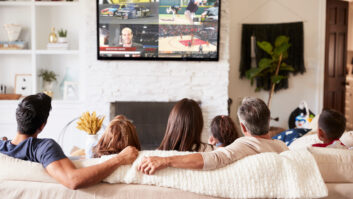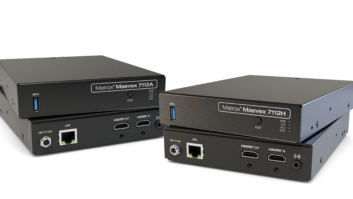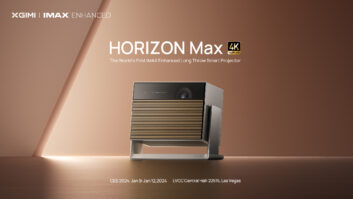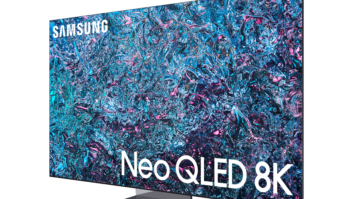At the very first CES, more than 50 years ago, the main product categories were audio and video. Audio, for the most part, consisted of “phonographs,” “stereos,” and radios, while video was, well, “TV sets,” because that is all there was in that category. My, how times have changed!
An incredible number of new product categories were on display at International CES 2018, many in product categories that could not even be imagined back when show launched. Yes, much has changed, but there is one thing that remains constant: “TV,” perhaps now better classified as “video” remains as a critical and core component of show.

The video category now encompasses many things, but in total it still is at the core of the custom residential industry and is a significant contributor to most businesses’ revenue and profit (if done correctly). Video formats, meanwhile, have been a constant source of change, particularly in the past 10 years or so. We’ve gone from B&W to color, spent some time with 3D, and gone from SD to HD to UHD, and leaped from SDR to HDR. At the same time, form factors and display technologies have evolved. Big boxes, whether direct view, front projection, or rear projection all were once CRT based. Now, we have flat screens with many variants of LCD and OLED as well as ceiling, floor, and short-throw projectors. We’ve gone from RF to analog composite video, to S-Video to HDMI as the connectivity pipe.

On the Horizon
Once an exotic novelty, 4K/UHD has become the norm, virtually taking over the market for displays over 40 inches. Of course, always on the lookout for the next step, many expected this year’s CES to be the coming-out party for 8K. Let’s say that it was, and at the same time it wasn’t.
Impressive 8K products were on display from the major legacy brands, including Sony, Samsung, Sharp, and LG. It was also shown at the booths of many of the up-and-coming China-based brands and panel suppliers, including Hisense, Konka, Huawei, BOE, among others.
Yes, there is no doubt that the image quality was beyond spectacular. Yes, the upscaling from 4K to 8K made great pictures even better. However, coming out of CES a few words of caution are in order. First, though some brands were giving vague availability timing for 8K products, none would give a hard in-market date, let alone even a guess at the pricing. (Hint: This is not going to be cheap.) Next, other than a 27-inch concept set shown off the floor by Sharp, none of the displays were smaller than 70 inches. Perhaps that is good, as that allows the viewer to be at least a bit back from the screen to get some benefit for the resolution increase without having their noses in the screen. Oh, and did I mention that while there continue to be tests that will include the Winter Olympics, 8K content won’t be broadly available for some time, and then only in Japan, until the 2020 Summer Olympics.
Even if there is 8K content, there is still no indication of what the streaming or physical media options will be and how one would connect to them. Yes, you might say HDMI 2.1, but we’ll get to that shortly. Cable or satellite? Sure, but they haven’t done much to date for 4K. Over-the-air? It’s unlikely that the new ATSC 3.0 system could carry it, even if broadcasters wanted to; given the costs involved, it’s unlikely that they would. Streaming? Until there is wider availability of 5G or gigabit connectivity, it isn’t likely there, either.
Don’t get me wrong. The images were incredible, and the HDR color impressive. It’s just that with pricing still not announced and content largely unavailable, this is something that anyone other than the most well heeled early adaptor would be wise to avoid. Tell anyone who asks that it will (probably) happen, that the images were great, and that even when fed 4K or HD content the upscaling definitely made a difference one could see. However, based on the state of 8K coming out of CES 2018, it is something to keep and eye on for the future.
While true 8K displays at an affordable price may be a bit off in the distance, they may bring one thing to market that we will see sooner than later. The huge task of processing the incoming 8K signals or upscaling 4K or HD video to 8K requires a new and more powerful generation of video processors. That was key to many of the 8K sets shown at CES, including those from Samsung and Sony. No better example of how these new processing engines would work in existing 4K sets was Sony’s X1 Extreme processor demo’d in a 4K panel. No, the result couldn’t match the 10,000 nit 8K set, but it was almost as good. Sign me up for one of those as soon as it is available, though at this time it is still a concept model.
Evolving Forms
Form factor and panel technologies are also things that have evolved since the first CES. Perhaps the largest amount coverage for any TV in Las Vegas last month was The Wall, from Samsung. A 4K, 146-inch goliath, it combines a new technology with a new (to the consumer display world) technology. The Wall is constructed with an array of individual panels that add up to thousands of self-emitting, microLED elements. Considerably smaller that even the finest pitch direct-LED displays, the result is an image of stunning clarity.
Since The Wall is built from smaller modules, it will be possible to blend them together to create different sizes and resolutions. Right now, however, the first task is to get it to market. When will that be? At CES the comments from Samsung vaguely pointed to some time this year, but mostly for commercial applications. The price? Again, no comment, but the general feeling is, “If you have to ask, you can’t afford it! Thus, along with 8K, this is something that you need to be aware of, but don’t plan on installing it any time soon. Also keep in mind that as a solid wall, and not a perforated screen, there is no way to put LCR speakers behind the screen. To be sure, particularly with the audio and DSP prowess of JBL and Harman now part of Samsung, a solution is in the works. It just isn’t here yet.



The other interesting departure from the norm in terms of screen form factor and technology is one you may have read about: the 65-inch rollable OLED from LG Display. In case you haven’t heard or seen this, picture a conventional projection screen that rolls up from a floor-mounted box. Then imagine that it isn’t a screen that you point a projector at, but rather the display itself. Yes, this is a 4K/UHD OLED with the same image quality as a standard, fixed front panel. To be sure, it’s rather amazing.
At risk of turning into “Debbie Downer,” there are some words of caution here, too. First, this is a rollable, not bendable display. You can’t wrap it around a column, as the display only works when the display is flat. More importantly, don’t try to take orders for this one, either. As impressive as it is, this is still somewhat of a science experiment. Coming from LG Display, not LG Electronics, this is a project of the business unit that makes displays and supplies them to LG and a wide range of other manufacturers and brands to develop finished products. LG Display wasn’t at CES to sell this to you, but rather to those who do sell to you.
Estimated pricing and availability? There was no comment on that. At this point there was not even an indication as to whether or not it will ever come to market, or from whom. How to handle questions from clients about this one? That’s easy. Explain exactly what it was: a technology concept demonstration. Then, explain that if a “hidden screen that rolls out of the ceiling or up from the floor is what is desired you can provide now, albeit with the help of projector.

Toward that form factor, “ultra-short throw” projectors were just about everywhere at CES 2018. Sony showed a new model with built-in audio using unique speakers with organic glass tweeters. Also showing this type of configuration was Hisense, while LG unveiled a pedestal-mounted 4K projector. Roll the screen down for these as you normally would, and you’re getting close to the “rollable” and able to deliver it today.
In the early days of CES, the choice of connection to the set was easy: RF, RF, or RF. As source options grew to include cable set tops, followed by VCRs, satellite STBs, various optical disc formats, and more recently streaming devices the connection pipe as moved from analog to digital. Here, for most residential, entertainment, applications that pipe has become HDMI.
In what some might call a Groundhog Day moment, the HDMI 2.1 format was once again the subject of discussion. The format, itself, is the same as when it was first unveiled last year. And, paraphrasing an old cliché, “It’s the same as it was last year, a year away.” Make no mistake about it, HDMI 2.1 is definitely going to happen. It will deliver 48 Gbps capability to allow video up to 10K, eARC for enhanced audio from TVs down to AVRs or sound bars, dynamic HDR, and everything else we’ve been promised to accommodate the video formats of the present and the future.
However, the question, once again, is when? The format was officially released back in November and chipmakers, test equipment suppliers, cable manufacturers, and more are all racing to get the missing pieces in place. Match that up against the product development and introduction schedules for source (optical players, STBs, and streaming devices), repeaters (AVRs or processors), and sinks (displays) and it still looks to be at least nine months out before we see the first products, and perhaps not until CES 2019 before it is widely available.
Again, HDMI 2.1 is on the way. It is going to happen. Just remember to match up the many benefits it will deliver against the replacement/update/upgrade cycle for your clients. Then, guide your “when do I need it” against what they watch, and what they watch it on.
Under Control
Remote controls have been an integral part of the video products shown at CES from the very beginning. This year, the hot topic was not so much the “remote” as it was the “control.” Perhaps as with virtually every CE product category on display, almost every aspect of video incorporated some measure of voice control. Of course, TV sets, but also projectors, streaming devices such as Roku, and DVRs such as TiVo. “Alexa, turn on the TV,” or “OK Google, search for a Star Wars movie.”

While Alexa did not have any floor presence, one only needed to walk the aisles of CES to see “Alexa Compatible” on just about everything. Google Assistant? The search powerhouse was very visible.

For video products, it is sometimes easy, with some brands and products offering both command schemes. In other cases, it is one or the other, but not both. Guide yourself accordingly, putting the set’s features and capabilities first. Then you can provision for the voice control, using one system, the other, or both. Also remember that some of the video products are “enabled,” meaning that they can react to, but not “hear” and transmit commands. Regardless, voice control for video products was a major change seen for the first time at CES 2018.
Along those lines, some of the brands, particularly LG and Samsung made the point of including voice control/UI for TVs and other video products not just a standalone feature, but rather the integral part of brand-wide system and UI integration. Particularly with both of those brands also market-share leaders for kitchen and laundry products it doesn’t take too much imagination to see where this fits into the greater smart home infrastructure. Don’t ignore this in your system planning.
Format Wars
Last, but certainly not least, CES has always been a venue where multiple formats where unveiled, promoted, and counted as to which products had which one. At CES 2018, it wasn’t as much about new formats as it was about the adoption of existing formats. The royalty-free HDR10 format has become the baseline, available in most 4K sets that Residential Systems readers will provide. Above that, things have gotten interesting.
To allow for dynamic, scene-by-scene, or even frame-by-frame adjustment, rather than a static “one setting per program,” Dolby Vision has been the only choice to date. Some TV brands have adopted it and Dolby Vision content is available from both streaming services and physical media. Sony, LG, TCL, and Vizio and others have adopted it for some models, with Samsung the most notable abstention.
Filling the bill as a royalty-free alternative, Samsung has made HDR10+ available to set manufacturers and content providers. It does not offer the color bit depth and light output potential of Dolby Vision, but it will be interesting to see if the lower cost sees it adopted in a broader range of products. At CES, Samsung announced that HDR10+ content will be available from Warner Brothers, as well as the previously announced 20th Century Fox. Panasonic announced that they were signing on to the HDR10+ ranks with an UltraHD Blu ray player. The latter made possible by the announcement that HDR10+ has been adopted as part of the UltraHD Blu ray format.
It’s unlikely that you’ll see both Dolby Vision and HDR10+ in the same display for HDR playback of recorded content. That is different from what you’ll see for live/broadcast content. HDR10 has already been tested for some 4K satellite transmission, but it is a bit complicated due to the lack of backwards compatibility with SDR. Two other formats, Hybrid Log Gamma (HLG), developed by NHK and BBC, Advanced HDR by Technicolor, also co-developed with Philips, avoid the need to do two separate feeds for live transmission.
Thus, both of those formats co-exist with HDR10 and Dolby Vision, with those aimed more at recorded, rather than live, content. Some manufacturers have already included both HLG and Advanced HDR. The latter gained a new adherent at CES from Philips, not surprising given that company’s participation in the format’s creation. The best part of the demo on display at the P&F booth, the company that is the exclusive licensee for Philips-branded TVs in North America, was seeing it in a demo in Full HDR, rather than 4K. Watching playback of a Dodgers game the improvement was clearly visible. If that leads to an HDR format that will gain traction not only for live TV, but also for use in HD programming we will have a major new selling point. Be on the look out for this as we move through the year.
There was more video news at CES 2018, and we’ll discuss it here in the months ahead. However, with space at a premium for this month let’s close by saying that as much as technology has changed in the since CES 1967, some things remain the same. Products, formats, form factors and connectivity may change, but the onus remains on us to evaluate not only the quality and market place availability of all the shiny objects on display. Only by doing that will you be able to retain existing clients and win bids for projects from new ones.

